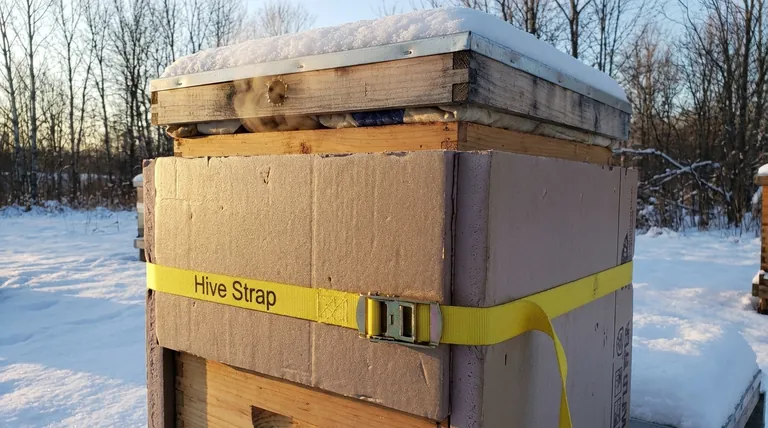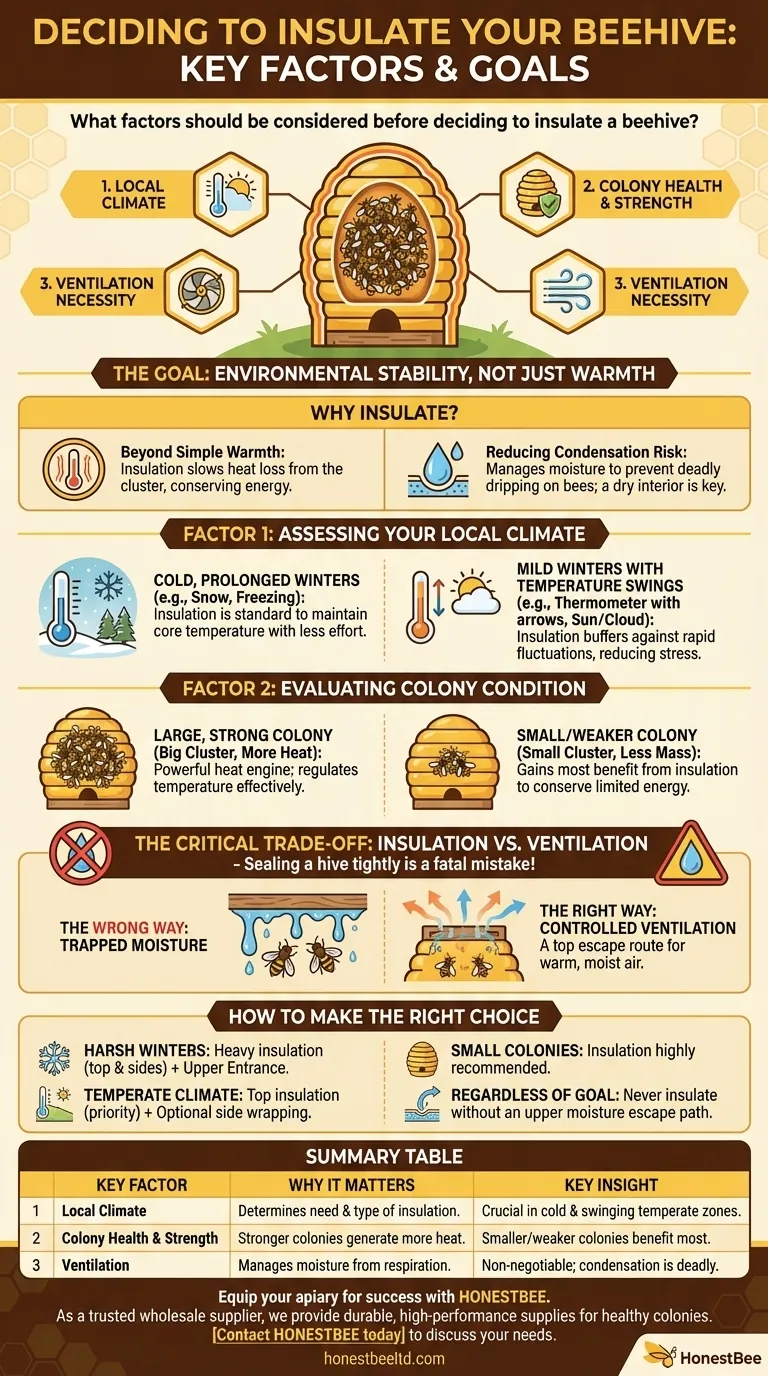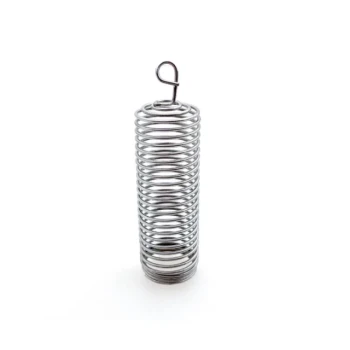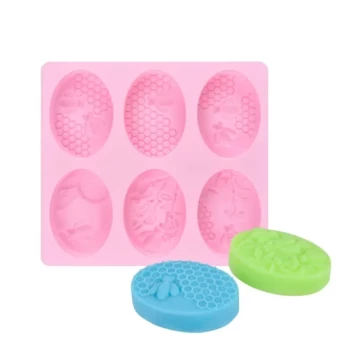Before insulating a beehive, the three most critical factors to evaluate are your local climate, the specific health and strength of your colony, and the absolute necessity of proper ventilation. Insulation is not a universal solution; it is a tool to be applied thoughtfully. Misjudging these factors can trap moisture and do more harm than good.
The core decision is not simply about keeping bees warm—they do that themselves. The true goal of insulation is to create a stable, dry interior environment that reduces temperature swings and prevents deadly condensation, thereby helping the colony conserve its precious winter food stores.

Why Insulate? The Goal of Environmental Stability
Many beekeepers assume insulation is just about adding warmth, but the physics are more nuanced. Bees don't heat the entire hive cavity; they heat their cluster. Insulation helps them do this more efficiently.
Beyond Simple Warmth
A honey bee cluster generates heat by vibrating its flight muscles. In colder temperatures, the cluster tightens to conserve this heat. Insulation acts like a thermal buffer, slowing the rate at which the heat generated by the cluster escapes the hive.
Reducing Condensation Risk
The most significant benefit of proper insulation is moisture management. As the bees respire, they release warm, moist air. When this air hits a cold inner surface of the hive, it condenses into water droplets, which can drip back down onto the cluster, chilling and killing the bees. Moisture, not cold, is the primary killer of overwintering colonies.
Conserving Winter Stores
Maintaining the cluster's temperature requires energy, which comes from consuming honey. By slowing heat loss, insulation allows the colony to burn through less of its vital winter food supply, increasing its chances of survival until the first spring nectar flow.
Factor 1: Assessing Your Local Climate
Your geographic location is the first and most obvious consideration. The need for and type of insulation varies dramatically with climate patterns.
Cold, Prolonged Winters
In regions with consistently freezing temperatures and significant snowfall (e.g., Canada, the northern United States, Scandinavia), insulation is a standard and highly beneficial practice. It helps the colony maintain its core temperature with less effort over a long period.
Mild Winters with Temperature Swings
In more temperate climates, insulation can be just as crucial. It's not about the deep cold but about buffering against rapid temperature fluctuations. A sudden warm spell can encourage the bees to break cluster, only to be stressed by a rapid freeze the next day. Insulation dampens these swings.
Factor 2: Evaluating Your Colony's Condition
Not all colonies are created equal. A large, thriving colony has a very different internal environment than a small, struggling one.
Colony Size and Strength
A large, populous colony with tens of thousands of bees is a powerful heat engine. It can regulate its temperature far more effectively than a small, late-season nucleus colony (nuc). Smaller colonies gain the most significant benefit from insulation, as they have less thermal mass and fewer bees to generate heat.
Colony Health and Resources
Insulation is a supportive measure, not a cure. It will help a healthy, well-fed colony with a low varroa mite load to thrive through winter. However, it will not save a weak colony suffering from disease or starvation. Ensure your bees are healthy and have ample food stores before considering insulation.
The Critical Trade-off: Insulation vs. Ventilation
This is the single most misunderstood aspect of preparing a hive for winter. Sealing a hive tightly to "keep it warm" is a fatal mistake.
The Dangers of Trapped Moisture
As mentioned, bees release a great deal of water vapor. If this moisture cannot escape, it will condense inside the hive. A damp hive promotes mold and dysentery and will kill a colony quickly, even in mild temperatures. A well-insulated but unventilated hive is a death trap.
Creating an Escape Route for Damp Air
Proper winterization involves insulating the hive while simultaneously providing an escape path for moisture. This is typically achieved with an upper entrance or a moisture-absorbing quilt box at the top of the hive. This allows the warm, damp air to rise and exit without creating a cold draft through the cluster.
The Wrong Way to Insulate
Avoid simply shrink-wrapping the entire hive in plastic or sealing every crack. The goal is to wrap the sides and, most importantly, the top of the hive with a material that has a high R-value (like rigid foam board) while leaving a small ventilation port open at the top.
How to Make the Right Choice for Your Hive
Use the following guidelines to determine your strategy.
- If your primary focus is surviving harsh, long winters: Heavy insulation on the top and sides is a proven strategy, but you must pair it with a dedicated upper entrance for ventilation.
- If your primary focus is buffering a strong colony in a temperate climate: Top insulation is your highest priority to prevent condensation, while side wrapping is beneficial but less critical.
- If your primary focus is helping a small or late-season colony: Insulation is highly recommended to help them conserve the limited energy and heat they can produce.
- Regardless of your goal: Never insulate a hive without also ensuring a reliable path for moist air to escape from the top.
Ultimately, successful insulation creates a dry, stable environment that allows your bees to manage their own climate with minimal stress and energy loss.
Summary Table:
| Key Factor | Why It Matters | Key Insight |
|---|---|---|
| Local Climate | Determines the need for and type of insulation. | Insulation is crucial in both cold climates and temperate zones with temperature swings. |
| Colony Health & Strength | A strong colony is a better heat generator. | Smaller, weaker colonies benefit most from the energy-saving effects of insulation. |
| Ventilation | Manages moisture from bee respiration. | Proper ventilation is non-negotiable to prevent condensation, which is more deadly than cold. |
Equip your apiary for success with HONESTBEE. Proper insulation is just one part of a thriving beekeeping operation. As a trusted wholesale supplier, we provide commercial apiaries and equipment distributors with the durable, high-performance supplies needed to support healthy colonies year-round. Let our expertise help you make informed decisions for your business.
Contact HONESTBEE today to discuss your wholesale needs and ensure your bees have the best possible environment.
Visual Guide

Related Products
- Professional Galvanized Hive Strap with Secure Locking Buckle for Beekeeping
- Heavy-Duty Nylon Beehive Hive Strap with Stainless Steel Cinch Buckle
- Jenter Queen Rearing Kit Complete Set for Bee Breeding
- Langstroth Honey Bee Box Hive Boxes for Different Depths
- Nicot Queen Rearing Kit for Beekeeping and Grafting in Nicot System
People Also Ask
- What maintenance is required for hive straps? A Guide to Cam Buckle vs. Ratchet Strap Care
- What are the types of Emlocks available? Choose the Right Strap for Hive Security
- What is the advantage of using cam buckle straps? Secure Your Load Fast with Simple, Safe Tensioning
- What is the best length for straps used around beehives? Why 12 Feet is the Industry Standard
- What are the two styles of hive straps? Choose the Right Strap for Your Hive Security



















